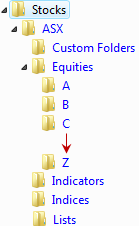LAYOUT & SECURITY TYPES
The ASX historical database is organised by "security type" into sub-folders beneath an "ASX" folder.
The table below shows the sub-folders and the securities they contain.
It also shows which security types are updated with each subscription option.
| Subscription Option |
ASX Subfolder |
Security Types |
|
Basic Subscription |
Equities |
Ordinary Shares (both partly and fully paid)
Preference Shares (both partly and fully paid)
Unit Trusts
Rights & Entitlements
Company Options
Exchange Traded Fund Units
|
| Indices |
S&P/ASX Indices |
|
Indicators |
Indicators |
Market Breadth
Economic
Implied Volatilities
|
Folder Layout
The "ASX" folder is installed by default to "c:\Trading Data\Stocks\ASX".
The illustration below shows the sub-folder layout:

|
Each sub-folder (except for "Indices") is further sub-divided into an A-Z structure.
This default A-Z structure can be eliminated (or re-built) through the Premium Data software.
In addition, Premium Data users can create their own Custom Folders based on lists of securities found in the Lists folder. |
ASX Security Descriptions
Equities
Ordinary Shares - equivalent to "Common Stock" in the U.S. -
the most common form of share ownership. Ordinary shareholders are
part-owners of a company. They have voting rights and are entitled to
dividends out of company profits, although preference share-holders are
always paid first. Ordinary shareholders also rank behind preference
shareholders and secured creditors in claims to a company's remaining
capital in the event of liquidation.
Preference Shares - shares that rank
before ordinary shares in entitlement to dividends and capital (see
above). Preference shares are often assigned a fixed rate of dividend
return.
Partly-paid Shares - also known as
Contributing Shares - shares on which the holder owes an outstanding
balance to the company, which may be called at some later date. If
the case of a No Liability Company, the holder has the option of
forfeiting the shares rather than paying the balance.
Unit Trusts - pooled
investments, where the funds are held with a trustee company and a
manager is employed to invest the funds on behalf of the unitholders.
Rights & Entitlements - new shares
made available to existing shareholders for purchase, the number of
shares being in proportion to the current holding. The new
shares are often issued at a discount to the current price. A rights
issue (renounceable) may be on-sold by an existing holder but an
entitlement issue (non-renounceable) must be either taken up or allowed
to lapse.
Company Options - securities issued by
a company, which bind it to issue shares to the option-holder at a
certain price (and at a certain time) if the holder chooses to take up
those shares.
Exchange Traded Fund Units - hybrid
securities that trade on the ASX equities market. An ETF is a managed
index fund whose units trade like ordinary shares. ETFs offer direct and
convenient exposure to the performance of an index like the S&P/ASX
200.
Back to Top
Indices
The S&P/ASX Indices are those indices calculated and managed by
Standard & Poors that are published daily by the ASX.
In April 2000, the ASX's Index business was contracted out to
Standard & Poors. The exchange's hope was that a global index manager
working to international standards would bring a higher international
profile to the exchange. S&P immediately began to make changes to the
indices, introducing the S&P/ASX 200 (amongst others) and modifying the
existing All Ordinaries Index.
Back to Top
Indicators
Market Breadth
XTOADV = S&P/ASX 100 Advancing Issues & Volume
XTODEC = S&P/ASX 100 Declining Issues & Volume
XTOUNC = S&P/ASX 100 Unchanged Issues & Volume
XTOADR = S&P/ASX 100 Advance/Decline Ratio
XTOAD = S&P/ASX 100 Cumulative Advance-Decline Line
#XFLAD = S&P/ASX 50 Cumulative Advance-Decline Line
#XJOAD = S&P/ASX 200 Cumulative Advance-Decline Line
#XKOAD = S&P/ASX 300 Cumulative Advance-Decline Line
#XSOAD = S&P/ASX Small Ordinaries Cumulative Advance-Decline Line
#XAOAD = All Ordinaries Cumulative Advance-Decline Line
#ASXAD = ASX Total Market Cumulative Advance-Decline Line
XJO52W = S&P/ASX 200 Cumulative 52 Week New Highs-New Lows Line
XAO52W = All Ordinaries Cumulative 52 Week New Highs-New Lows Line
XJO26W = S&P/ASX 200 Cumulative 26 Week New Highs-New Lows Line
XAO26W = All Ordinaries Cumulative 26 Week New Highs-New Lows Line
XJO20 = S&P/ASX 200 % Stocks above Moving Average 20
XJO50 = S&P/ASX 200 % Stocks above Moving Average 50
XJO100 = S&P/ASX 200 % Stocks above Moving Average 100
XJO150 = S&P/ASX 200 % Stocks above Moving Average 150
XJO200 = S&P/ASX 200 % Stocks above Moving Average 200
XAO20 = All Ordinaries % Stocks above Moving Average 20
XAO50 = All Ordinaries % Stocks above Moving Average 50
XAO100 = All Ordinaries % Stocks above Moving Average 100
XAO150 = All Ordinaries % Stocks above Moving Average 150
XAO200 = All Ordinaries % Stocks above Moving Average 200
Economic
#AUBLD = AU Building Approvals Total
#AUCAB = AU Current Account Balance
#AUCPI = AU Inflation Rate
#AUGDP = AU Gross Domestic Product Rate
#AUJOB = AU Unemployment Rate
%AURBA = RBA Cash Rate Target
Implied Volatilities
For 60-70 leading stocks.
An Implied Volatility for a stock is created by taking the basket of Exchange Traded Options that trade against the stock,
determining the implied volatility that is priced into each option and then averaging those volatilities to arrive at a single figure.
The result is an instantaneous measure of expected volatility rather than a look-back at historical volatility.
This method was popularised by the CBOE for the S&P 500 Volatility Index (VIX) and is often called the "Investor Fear Gauge".
Back to Top
|

